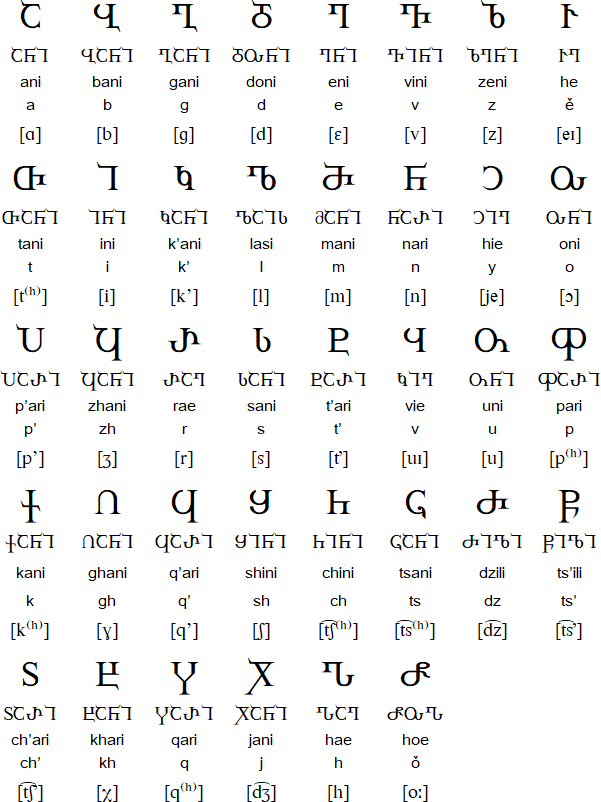The Georgian language first appeared in writing in about 430 AD in an inscription in a church in Palestine. At that time it was written with an alphabet known as Mrglovani ("rounded"). It later came to be known as Asomtavruli ("capital letters"). Asomtavruli was probably modelled on the Greek alphabet, and Georgian scholars believe that King Pharnavaz I (ფარნავაზი) of Kartli (Iberia) created it.
From the 9th century an alphabet that developed from Asomtavruli, known as Nuskhuri, became the main alphabet for Georgian. However, Asomtavruli continued to be used in some manuscripts until the 11th century, and in epigraphic inscriptions until the 19th century. Asomtavruli was also used for titles and the first letters of chapters and paragraphs in texts written in Nuskhuri. The initial letters were often elaboratly illuminated and decorated. This mixed script is known as Khutsuri ("clerical").
In the 19th century the Mkhedruli alphabet, which first appeared in the 10th century, became the main way to write Georgian.
In the 1950s a Georgian linguist called Akaki Shanidze (აკაკი შანიძე) proposed using Asomtavruli letters in Mkhedruli texts as capital letters at the beginning of sentences. This idea did not prove popular.
Asomtavruli continues to be used in murals, iconography and stone engravings, and is one of the official scripts of the Georgian Orthodox Church, along with Nuskhuri and Mkhedruli.

Download Georgian alphabet charts in Excel, Word or PDF format

q'vela adamiani ibadeba tavisupali da tanasts'ori tavisi ghirsebita da uplebebit. mat gaachniat goneba da sindisi da ertmanetis mimart unda iktseodnen da-dzmobis sulisk'vetebit.
All human beings are born free and equal in dignity and rights. They are endowed with reason and conscience and should act towards one another in a spirit of brotherhood.
(Article 1 of the Universal Declaration of Human Rights)
Information about Georgian | Mkhedruli alphabet | Nuskhuri alphabet | Asomtavruli alphabet | Phrases | Numbers | Tower of Babel | Songs | Learning materials
Information about the Asomtavruli alphabet
https://en.wikipedia.org/wiki/Georgian_scripts#Asomtavruli
https://ai.glossika.com/blog/learn-the-georgian-alphabet-2-asomtavruli
Abkhaz, Batsbi, Georgian, Laz, Mingrelian, Svan
A-chik Tokbirim, Adinkra, ADLaM, Armenian, Avestan, Avoiuli, Bactrian, Bassa (Vah), Beitha Kukju, Beria (Zaghawa), Borama / Gadabuursi, Carian, Carpathian Basin Rovas, Chinuk pipa, Chisoi, Coorgi-Cox, Coptic, Cyrillic, Dalecarlian runes, Elbasan, Etruscan, Faliscan, Fox, Galik, Georgian (Asomtavruli), Georgian (Nuskhuri), Georgian (Mkhedruli), Glagolitic, Global Alphabet, Gothic, Greek, Hurûf-ı munfasıla, Irish (Uncial), Kaddare, Kayah Li, Khatt-i-Badíʼ, Khazarian Rovas, Koch, Korean, Latin, Lepontic, Luo Lakeside Script, Lycian, Lydian, Manchu, Mandaic, Mandombe, Marsiliana, Medefaidrin, Messapic, Mongolian, Mro, Mundari Bani, Nag Chiki, Naasioi Otomaung, N'Ko, North Picene, Novo Tupi, Nyiakeng Puachue Hmong, Odùduwà, Ogham, Old Church Slavonic, Oirat Clear Script, Ol Chiki (Ol Cemet' / Santali), Old Italic, Old Nubian, Old Permic, Ol Onal, Orkhon, Osage, Oscan, Osmanya (Somali), Pau Cin Hau, Phrygian, Pollard script, Runic, Székely-Hungarian Rovás (Hungarian Runes), South Picene, Sutton SignWriting, Sunuwar, Tai Viet, Tangsa, Todhri, Toto, Umbrian, (Old) Uyghur, Wancho, Yezidi, Zoulai
Page last modified: 15.03.23
[top]
You can support this site by Buying Me A Coffee, and if you like what you see on this page, you can use the buttons below to share it with people you know.

If you like this site and find it useful, you can support it by making a donation via PayPal or Patreon, or by contributing in other ways. Omniglot is how I make my living.
Note: all links on this site to Amazon.com, Amazon.co.uk
and Amazon.fr
are affiliate links. This means I earn a commission if you click on any of them and buy something. So by clicking on these links you can help to support this site.
[top]